Qing Cui
Ring-lite: Scalable Reasoning via C3PO-Stabilized Reinforcement Learning for LLMs
Jun 18, 2025Abstract:We present Ring-lite, a Mixture-of-Experts (MoE)-based large language model optimized via reinforcement learning (RL) to achieve efficient and robust reasoning capabilities. Built upon the publicly available Ling-lite model, a 16.8 billion parameter model with 2.75 billion activated parameters, our approach matches the performance of state-of-the-art (SOTA) small-scale reasoning models on challenging benchmarks (e.g., AIME, LiveCodeBench, GPQA-Diamond) while activating only one-third of the parameters required by comparable models. To accomplish this, we introduce a joint training pipeline integrating distillation with RL, revealing undocumented challenges in MoE RL training. First, we identify optimization instability during RL training, and we propose Constrained Contextual Computation Policy Optimization(C3PO), a novel approach that enhances training stability and improves computational throughput via algorithm-system co-design methodology. Second, we empirically demonstrate that selecting distillation checkpoints based on entropy loss for RL training, rather than validation metrics, yields superior performance-efficiency trade-offs in subsequent RL training. Finally, we develop a two-stage training paradigm to harmonize multi-domain data integration, addressing domain conflicts that arise in training with mixed dataset. We will release the model, dataset, and code.
SHARP: Synthesizing High-quality Aligned Reasoning Problems for Large Reasoning Models Reinforcement Learning
May 21, 2025Abstract:Training large reasoning models (LRMs) with reinforcement learning in STEM domains is hindered by the scarcity of high-quality, diverse, and verifiable problem sets. Existing synthesis methods, such as Chain-of-Thought prompting, often generate oversimplified or uncheckable data, limiting model advancement on complex tasks. To address these challenges, we introduce SHARP, a unified approach to Synthesizing High-quality Aligned Reasoning Problems for LRMs reinforcement learning with verifiable rewards (RLVR). SHARP encompasses a strategic set of self-alignment principles -- targeting graduate and Olympiad-level difficulty, rigorous logical consistency, and unambiguous, verifiable answers -- and a structured three-phase framework (Alignment, Instantiation, Inference) that ensures thematic diversity and fine-grained control over problem generation. We implement SHARP by leveraging a state-of-the-art LRM to infer and verify challenging STEM questions, then employ a reinforcement learning loop to refine the model's reasoning through verifiable reward signals. Experiments on benchmarks such as GPQA demonstrate that SHARP-augmented training substantially outperforms existing methods, markedly improving complex reasoning accuracy and pushing LRM performance closer to expert-level proficiency. Our contributions include the SHARP strategy, framework design, end-to-end implementation, and experimental evaluation of its effectiveness in elevating LRM reasoning capabilities.
MASS: Mathematical Data Selection via Skill Graphs for Pretraining Large Language Models
Mar 19, 2025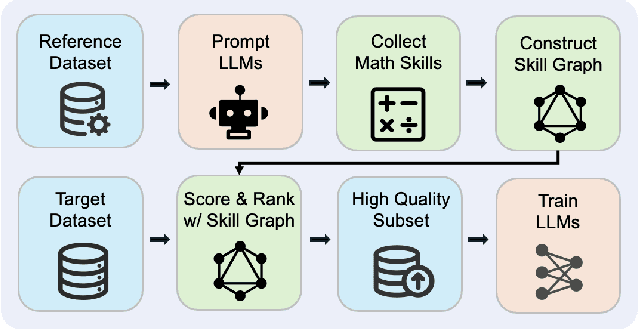

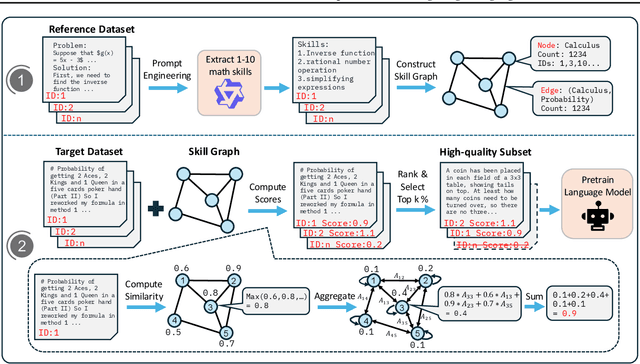

Abstract:High-quality data plays a critical role in the pretraining and fine-tuning of large language models (LLMs), even determining their performance ceiling to some degree. Consequently, numerous data selection methods have been proposed to identify subsets of data that can effectively and efficiently enhance model performance. However, most of these methods focus on general data selection and tend to overlook the specific nuances of domain-related data. In this paper, we introduce MASS, a \textbf{MA}thematical data \textbf{S}election framework using the \textbf{S}kill graph for pretraining LLMs in the mathematical reasoning domain. By taking into account the unique characteristics of mathematics and reasoning, we construct a skill graph that captures the mathematical skills and their interrelations from a reference dataset. This skill graph guides us in assigning quality scores to the target dataset, enabling us to select the top-ranked subset which is further used to pretrain LLMs. Experimental results demonstrate the efficiency and effectiveness of MASS across different model sizes (1B and 7B) and pretraining datasets (web data and synthetic data). Specifically, in terms of efficiency, models trained on subsets selected by MASS can achieve similar performance to models trained on the original datasets, with a significant reduction in the number of trained tokens - ranging from 50\% to 70\% fewer tokens. In terms of effectiveness, when trained on the same amount of tokens, models trained on the data selected by MASS outperform those trained on the original datasets by 3.3\% to 5.9\%. These results underscore the potential of MASS to improve both the efficiency and effectiveness of pretraining LLMs.
Every FLOP Counts: Scaling a 300B Mixture-of-Experts LING LLM without Premium GPUs
Mar 07, 2025



Abstract:In this technical report, we tackle the challenges of training large-scale Mixture of Experts (MoE) models, focusing on overcoming cost inefficiency and resource limitations prevalent in such systems. To address these issues, we present two differently sized MoE large language models (LLMs), namely Ling-Lite and Ling-Plus (referred to as "Bailing" in Chinese, spelled B\v{a}il\'ing in Pinyin). Ling-Lite contains 16.8 billion parameters with 2.75 billion activated parameters, while Ling-Plus boasts 290 billion parameters with 28.8 billion activated parameters. Both models exhibit comparable performance to leading industry benchmarks. This report offers actionable insights to improve the efficiency and accessibility of AI development in resource-constrained settings, promoting more scalable and sustainable technologies. Specifically, to reduce training costs for large-scale MoE models, we propose innovative methods for (1) optimization of model architecture and training processes, (2) refinement of training anomaly handling, and (3) enhancement of model evaluation efficiency. Additionally, leveraging high-quality data generated from knowledge graphs, our models demonstrate superior capabilities in tool use compared to other models. Ultimately, our experimental findings demonstrate that a 300B MoE LLM can be effectively trained on lower-performance devices while achieving comparable performance to models of a similar scale, including dense and MoE models. Compared to high-performance devices, utilizing a lower-specification hardware system during the pre-training phase demonstrates significant cost savings, reducing computing costs by approximately 20%. The models can be accessed at https://huggingface.co/inclusionAI.
Mix Data or Merge Models? Balancing the Helpfulness, Honesty, and Harmlessness of Large Language Model via Model Merging
Feb 13, 2025Abstract:Achieving balanced alignment of large language models (LLMs) in terms of Helpfulness, Honesty, and Harmlessness (3H optimization) constitutes a cornerstone of responsible AI, with existing methods like data mixture strategies facing limitations including reliance on expert knowledge and conflicting optimization signals. While model merging offers a promising alternative by integrating specialized models, its potential for 3H optimization remains underexplored. This paper establishes the first comprehensive benchmark for model merging in 3H-aligned LLMs, systematically evaluating 15 methods (12 training-free merging and 3 data mixture techniques) across 10 datasets associated with 5 annotation dimensions, 2 LLM families, and 2 training paradigms. Our analysis reveals three pivotal insights: (i) previously overlooked collaborative/conflicting relationships among 3H dimensions, (ii) the consistent superiority of model merging over data mixture approaches in balancing alignment trade-offs, and (iii) the critical role of parameter-level conflict resolution through redundant component pruning and outlier mitigation. Building on these findings, we propose R-TSVM, a Reweighting-enhanced Task Singular Vector Merging method that incorporates outlier-aware parameter weighting and sparsity-adaptive rank selection strategies adapted to the heavy-tailed parameter distribution and sparsity for LLMs, further improving LLM alignment across multiple evaluations. We release our trained models for further exploration.
Combining Incomplete Observational and Randomized Data for Heterogeneous Treatment Effects
Oct 28, 2024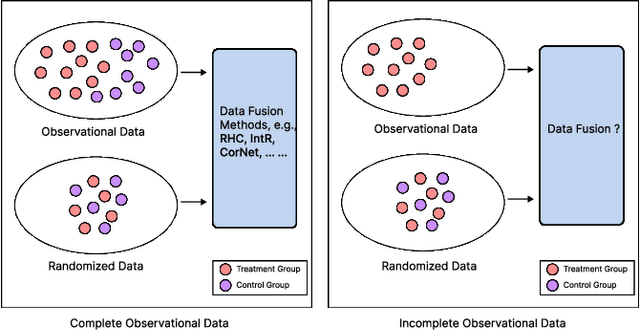
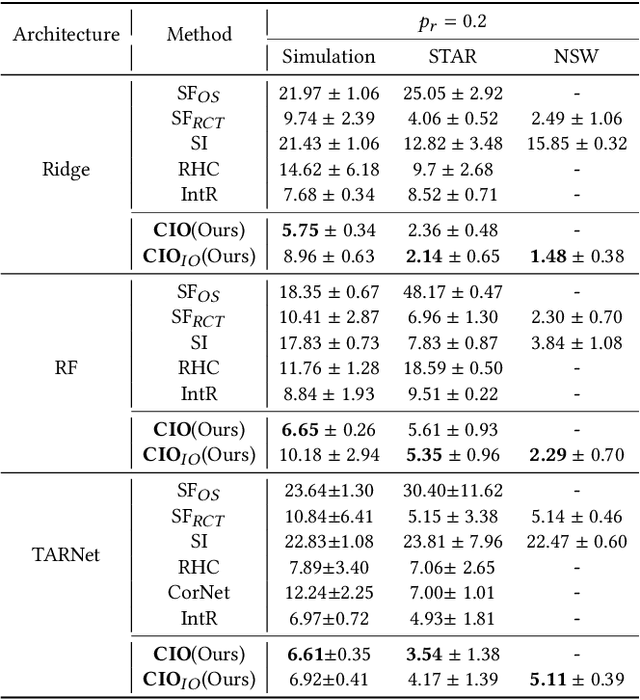
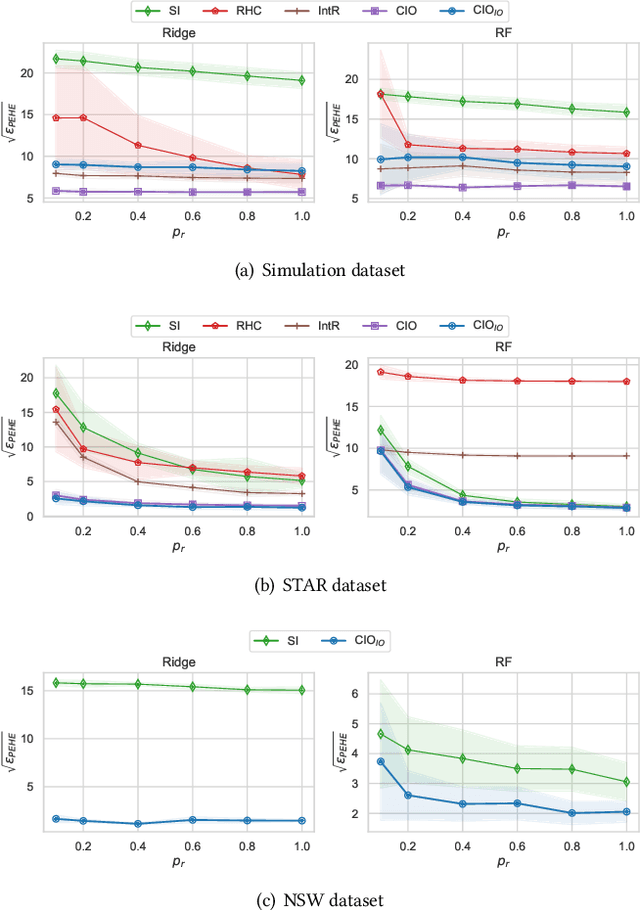

Abstract:Data from observational studies (OSs) is widely available and readily obtainable yet frequently contains confounding biases. On the other hand, data derived from randomized controlled trials (RCTs) helps to reduce these biases; however, it is expensive to gather, resulting in a tiny size of randomized data. For this reason, effectively fusing observational data and randomized data to better estimate heterogeneous treatment effects (HTEs) has gained increasing attention. However, existing methods for integrating observational data with randomized data must require \textit{complete} observational data, meaning that both treated subjects and untreated subjects must be included in OSs. This prerequisite confines the applicability of such methods to very specific situations, given that including all subjects, whether treated or untreated, in observational studies is not consistently achievable. In our paper, we propose a resilient approach to \textbf{C}ombine \textbf{I}ncomplete \textbf{O}bservational data and randomized data for HTE estimation, which we abbreviate as \textbf{CIO}. The CIO is capable of estimating HTEs efficiently regardless of the completeness of the observational data, be it full or partial. Concretely, a confounding bias function is first derived using the pseudo-experimental group from OSs, in conjunction with the pseudo-control group from RCTs, via an effect estimation procedure. This function is subsequently utilized as a corrective residual to rectify the observed outcomes of observational data during the HTE estimation by combining the available observational data and the all randomized data. To validate our approach, we have conducted experiments on a synthetic dataset and two semi-synthetic datasets.
LLM-Guided Multi-View Hypergraph Learning for Human-Centric Explainable Recommendation
Jan 16, 2024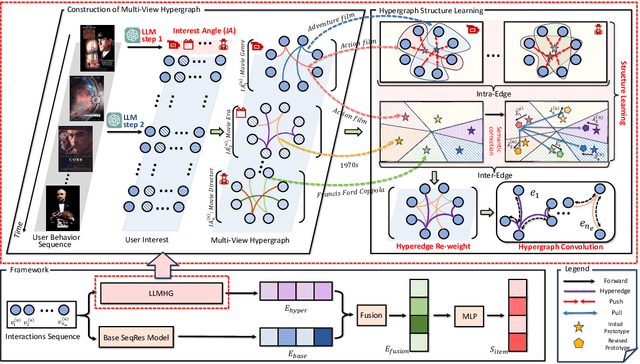
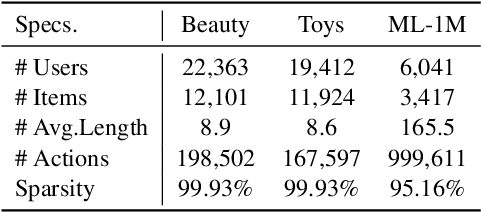


Abstract:As personalized recommendation systems become vital in the age of information overload, traditional methods relying solely on historical user interactions often fail to fully capture the multifaceted nature of human interests. To enable more human-centric modeling of user preferences, this work proposes a novel explainable recommendation framework, i.e., LLMHG, synergizing the reasoning capabilities of large language models (LLMs) and the structural advantages of hypergraph neural networks. By effectively profiling and interpreting the nuances of individual user interests, our framework pioneers enhancements to recommendation systems with increased explainability. We validate that explicitly accounting for the intricacies of human preferences allows our human-centric and explainable LLMHG approach to consistently outperform conventional models across diverse real-world datasets. The proposed plug-and-play enhancement framework delivers immediate gains in recommendation performance while offering a pathway to apply advanced LLMs for better capturing the complexity of human interests across machine learning applications.
Task-Driven Causal Feature Distillation: Towards Trustworthy Risk Prediction
Dec 20, 2023



Abstract:Since artificial intelligence has seen tremendous recent successes in many areas, it has sparked great interest in its potential for trustworthy and interpretable risk prediction. However, most models lack causal reasoning and struggle with class imbalance, leading to poor precision and recall. To address this, we propose a Task-Driven Causal Feature Distillation model (TDCFD) to transform original feature values into causal feature attributions for the specific risk prediction task. The causal feature attribution helps describe how much contribution the value of this feature can make to the risk prediction result. After the causal feature distillation, a deep neural network is applied to produce trustworthy prediction results with causal interpretability and high precision/recall. We evaluate the performance of our TDCFD method on several synthetic and real datasets, and the results demonstrate its superiority over the state-of-the-art methods regarding precision, recall, interpretability, and causality.
Enhancing Event Sequence Modeling with Contrastive Relational Inference
Sep 06, 2023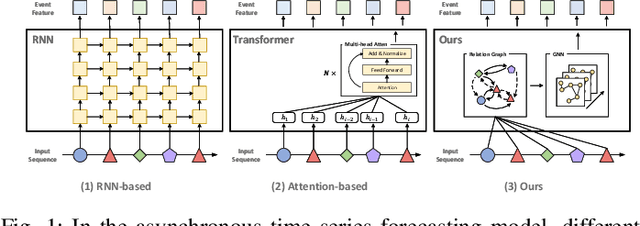
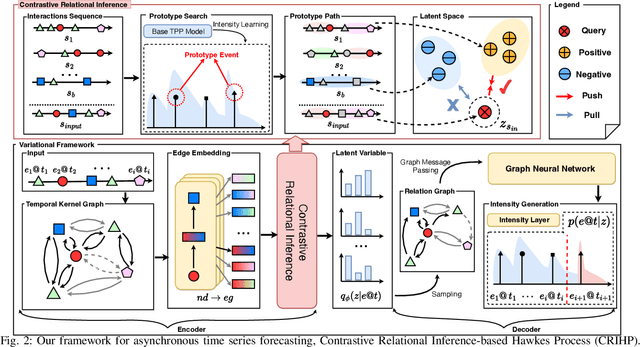
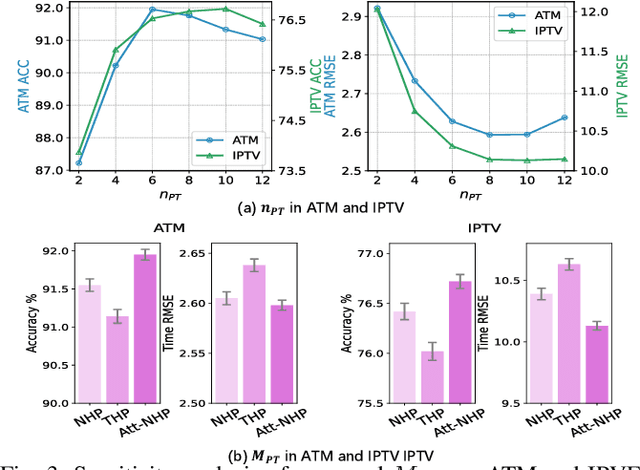

Abstract:Neural temporal point processes(TPPs) have shown promise for modeling continuous-time event sequences. However, capturing the interactions between events is challenging yet critical for performing inference tasks like forecasting on event sequence data. Existing TPP models have focused on parameterizing the conditional distribution of future events but struggle to model event interactions. In this paper, we propose a novel approach that leverages Neural Relational Inference (NRI) to learn a relation graph that infers interactions while simultaneously learning the dynamics patterns from observational data. Our approach, the Contrastive Relational Inference-based Hawkes Process (CRIHP), reasons about event interactions under a variational inference framework. It utilizes intensity-based learning to search for prototype paths to contrast relationship constraints. Extensive experiments on three real-world datasets demonstrate the effectiveness of our model in capturing event interactions for event sequence modeling tasks.
Leveraging Large Language Models for Pre-trained Recommender Systems
Aug 21, 2023



Abstract:Recent advancements in recommendation systems have shifted towards more comprehensive and personalized recommendations by utilizing large language models (LLM). However, effectively integrating LLM's commonsense knowledge and reasoning abilities into recommendation systems remains a challenging problem. In this paper, we propose RecSysLLM, a novel pre-trained recommendation model based on LLMs. RecSysLLM retains LLM reasoning and knowledge while integrating recommendation domain knowledge through unique designs of data, training, and inference. This allows RecSysLLM to leverage LLMs' capabilities for recommendation tasks in an efficient, unified framework. We demonstrate the effectiveness of RecSysLLM on benchmarks and real-world scenarios. RecSysLLM provides a promising approach to developing unified recommendation systems by fully exploiting the power of pre-trained language models.
 Add to Chrome
Add to Chrome Add to Firefox
Add to Firefox Add to Edge
Add to Edge